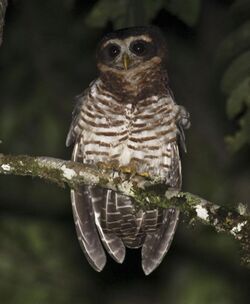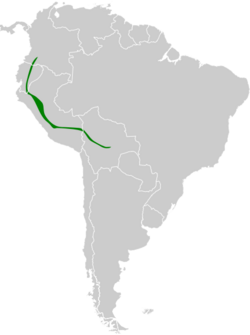Biology:Band-bellied owl
| Band-bellied owl | |
|---|---|

| |
| Scientific classification | |
| Domain: | Eukaryota |
| Kingdom: | Animalia |
| Phylum: | Chordata |
| Class: | Aves |
| Order: | Strigiformes |
| Family: | Strigidae |
| Genus: | Pulsatrix |
| Species: | P. melanota
|
| Binomial name | |
| Pulsatrix melanota (Tschudi, 1844)
| |

| |
The band-bellied owl (Pulsatrix melanota) is a species of owl in the family Strigidae. It is found in Bolivia, Colombia, Ecuador and Peru.[2]
Taxonomy and systematics
The band-bellied owl may form a superspecies with tawny-browed owl (Pulsatrix koeniswaldiana). It has been suggested that they are conspecific but they have different morphology and vocalizations.[3][4] The band-bellied owl has two subspecies, the nominate P. m. melanota and P. m. philoscia.[2]
Description
The band-bellied owl is fairly large, ranging from 44 to 48 cm (17 to 19 in) long.[4] An analysis of the weight of 13 birds of both sexes showed a range of 590 to 1,250 g (1.30 to 2.76 lb) and an average of 873 g (1.925 lb).[5] The adult has a dark brown facial disk and white "brows" over dark reddish brown eyes. Its upperparts are dark chocolate brown with scattered buffy-white spots. The tail is also dark brown, with thin white bars. The upper breast is reddish brown with buff barring. The rest of the underparts are white to creamy with reddish brown barring. The juvenile's plumage has not been described.[4]
Distribution and habitat
The nominate subspecies of band-bellied owl is found on the eastern slope of the Andes from central Colombia south through Ecuador and Peru. P. m. philoscia is found from there to west-central Bolivia. In elevation it ranges from about 650 to 2,200 m (2,130 to 7,220 ft). It primarily inhabits the interior of humid montane forest and foothills rainforest but is also found on forest edges and in clearings with scattered trees.[4]
Behavior
Feeding
The band-bellied owl is nocturnal. Its diet is poorly studied but is known to include large insects.[4]
Breeding
Though there is no published information on the band-bellied owl's breeding phenology, it is presumed to nest in natural tree cavities.[4]
Vocalization
The band-bellied owl's vocalizations are also poorly known. It is "[s]aid to give a short, deep trill followed by fast burst of popping notes", and "deep, muffled hoots" have been recorded in Peru. The sexes perform duets.[4]
Status
The IUCN has assessed the band-bellied owl as being of Least Concern.[6] However, the species is poorly known and "could be threatened by habitat loss".[4]
References
- ↑ "Appendices | CITES". https://cites.org/eng/app/appendices.php.
- ↑ 2.0 2.1 Gill, F.; Donsker, D.; Rasmussen, P. (July 2021). "IOC World Bird List (v 11.2)". https://www.worldbirdnames.org/.
- ↑ Remsen, J. V., Jr., J. I. Areta, E. Bonaccorso, S. Claramunt, A. Jaramillo, D. F. Lane, J. F. Pacheco, M. B. Robbins, F. G. Stiles, and K. J. Zimmer. Version 24 August 2021. A classification of the bird species of South America. American Ornithological Society. https://www.museum.lsu.edu/~Remsen/SACCBaseline.htm retrieved August 24, 2021
- ↑ 4.0 4.1 4.2 4.3 4.4 4.5 4.6 4.7 Holt, D. W., R. Berkley, C. Deppe, P. L. Enríquez, J. L. Petersen, J. L. Rangel Salazar, K. P. Segars, K. L. Wood, E. de Juana, and J. S. Marks (2020). Band-bellied Owl (Pulsatrix melanota), version 1.0. In Birds of the World (J. del Hoyo, A. Elliott, J. Sargatal, D. A. Christie, and E. de Juana, Editors). Cornell Lab of Ornithology, Ithaca, NY, USA. https://doi.org/10.2173/bow.babowl1.01 retrieved September 7, 2021
- ↑ Dunning, John B. Jr., ed (1992). CRC Handbook of Avian Body Masses. CRC Press. ISBN 978-0-8493-4258-5.
- ↑ Cite error: Invalid
<ref>tag; no text was provided for refs namedIUCN
Wikidata ☰ Q516398 entry
 |


